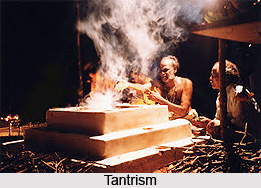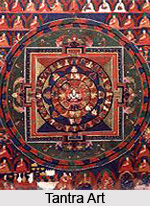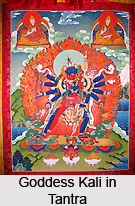
Tantric literature is mainly found encompassed in the Samhitas, Agamas and the Tantras. Strictly speaking, the Samhitas are the sacred books of the Vaishnavas, the Agamas those of the Shaivas and the Tantras those of the Saktas. However, there is no clear line of demarcation between the terms, and the expression `Tantra` is frequently used as a general term for this class of literary works. Tantric influences have already been noticed in several of the later Indian Puranas. These mostly occur in the form of references to the cult of the Shakti, (the female deities) considerable sections in the form of dialogues between Lord Shiva and Parvati and the occasional use of mystic syllables and formulas (mantras) and diagrams (Yantras). The Tantras, the Samhitas and the Agamas are completely theological works which seek to inculcate technicalities of the cult of certain sects together with their metaphysical and mystical principles. Tantra is an essential practice that evolved with the sages paving the way for tantric arts and way of living and tantra literature involves these essential formalities.
All these works, which encompass the body of Tantra literature, have certain characteristic features in common. Though they are not positively hostile to the Veda, they propound that the precepts of the Veda are too difficult for the post Vedic, modern age and for this reason, an easier cult and an easier doctrine have been revealed in them. Moreover these sacred books are accessible not only to the higher castes, but to Madras and women too. On the other hand, it is also true that they contain Secret Doctrines which can only be obtained from a teacher (Guru) after a ceremonial initiation (Diksa), and which must not be communicated to any uninitiated person.
A complete Tantra (Samhita, Agama) should consist of four parts according to the four main themes treated. These are:
(1) Jnana, "knowledge," comprising actual philosophical doctrines. Sometimes these doctrines have a monotheistic bias, and sometimes lean towards monism. There is also noticed in this Jnana a kind of confused occultism including the "knowing" of the secret powers of the letters, syllables, formulas and figures (Mantrasastra, Yantrasastra);
 (2) Yoga, i.e., "meditation, concentration," also more especially with a view to acquiring magic powers, hence also "magic" (Mayayoga);
(2) Yoga, i.e., "meditation, concentration," also more especially with a view to acquiring magic powers, hence also "magic" (Mayayoga);
(3) Kriya, "action," i.e., instructions for the making of idols and the construction and consecration of temples;
(4) Carya, "conduct," i.e., rules regarding rites and festivals, and social duties.
Though in reality all these four branches are not treated in every single one of these works, they all contain a medley of philosophy and occultism, mysticism and magic, and ritual and ethics.
However, when one speaks of Tantras, the reference is primarily to the sacred books of the Saktas, i.e., the worshippers of the Shaktis. They are energies conceived of as female deities, of the `Great Sakti,` `the Great Mother,` `the Goddess (Devi)`, who, in spite of her countless names (Goddess Durga, Goddess Kali etc.), is only one, the one `Highest Queen` (Paramesvari). Shaktism, the religion of the Saktas, presents a curious medley of the highest and lowest, the most sublime and the basest conceptions. In Shaktism and its sacred books, the Tantras, we find the highest ideas on the Deity and deep philosophical speculations along with the wildest superstition and confused occultism.
 A few of the Tantras themselves say that there are 64 Tantras, or 64 Tantras each, in three different parts of the world. However, the number of Tantras existing in manuscripts is far larger. Their original home seems to have been Bengal, from where they spread throughout Assam and Nepal, and even beyond India to Tibet and China through the agency of Buddhism. In reality they are known throughout the length and breadth of India, even in Kashmir and the South. As a rule the Tantras take the form of dialogues between Shiva and Parvati. When the Goddess asks the questions like a pupil and Shiva replies like a teacher, they are called Agamas. When the goddess is the teacher and answers Shiva`s questions, they are called Nigamas.
A few of the Tantras themselves say that there are 64 Tantras, or 64 Tantras each, in three different parts of the world. However, the number of Tantras existing in manuscripts is far larger. Their original home seems to have been Bengal, from where they spread throughout Assam and Nepal, and even beyond India to Tibet and China through the agency of Buddhism. In reality they are known throughout the length and breadth of India, even in Kashmir and the South. As a rule the Tantras take the form of dialogues between Shiva and Parvati. When the Goddess asks the questions like a pupil and Shiva replies like a teacher, they are called Agamas. When the goddess is the teacher and answers Shiva`s questions, they are called Nigamas.
Tantra literature thus comprises a number of religious instructions and philosophical doctrines as well as a certain amount of occultism.













